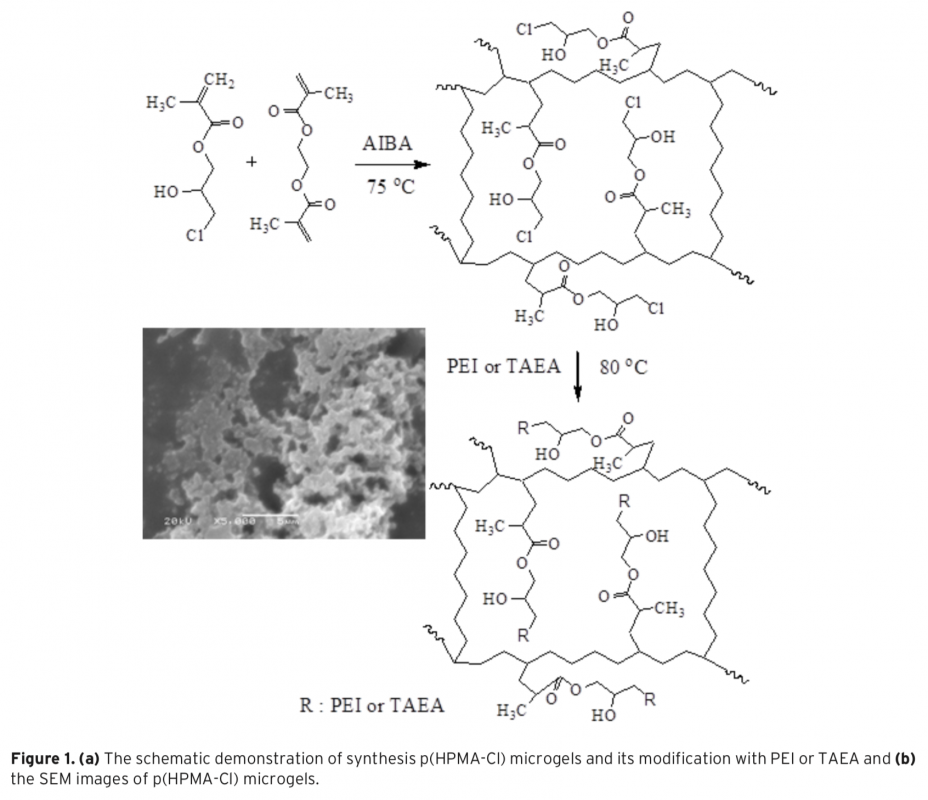Poly(3-chloro-2-hydroxypropyl methacrylate) (p(HPMA-Cl)) microgels were synthesized through surfactant-free emulsion polymerization technique (SFEP) by addition of ethylene glycol dimethacrylate (EGDMA) as a cross-linker. Next, the obtained p(HPMA-Cl) microgels were modified by using tris(2-aminoethyl)amine (TAEA) and poly(ethyleneimine) (PEI) as modifying agents. After modification, the synthesized microgels were named as poly(3-chloro-2-hydroxypropyl methacrylate)-tris(2-aminoethyl)amine (p(HPMA)-TAEA) and poly(3-chloro-2hydroxypropyl methacrylate)-poly(ethyleneimine) (p(HPMA)-PEI) microgels. Thermal decomposition kinetics of these microgels which were based on the p(HPMA-Cl) were then evaluated using thermo-gravimetric analysis. The kinetic parameters for the degradation reactions of p(HPMA-Cl)-based microgels, including the correlation coefficients and activation energy and mechanisms, were determined using the TGA-DTA data. Experimental data for p(HPMA-Cl), p(HPMA)-TAEA and p(HPMA)-PEI microgels were computed through twenty-four different thermal degradation models to evaluate the best-fitted model. The activation energies (Ea) of p(HPMA-Cl), p(HPMA)-TAEA and (p(HPMA)-PEI) microgels composites were determined by the Kissinger-Akahira Sunose (KAS), Flynn-Wall-Ozawa (FWO), Coats-Redfern, Ozawa and Friedman methods. Based on the results, nucleation-nuclei growth models seem to be the most suitable for these microgels.
Poli (3-kloro-2-hidroksipropil metakrilat) (p(HPMA-Cl)) mikrojelleri, surfektan içermeyen emülsiyon polimerizasyon tekniği (SFEP) ile sentezlenmiştir. Daha sonra p(HPMA-Cl) mikrojel, modifiye edici maddeler olarak tris(2-aminoetil) amin (TAEA) ve poli(etilenimin) (PEI) kullanılarak modifiye edilmiştir. Modifiye mikrojeller poli(3-kloro-2-hidroksipropil metakrilat)-tris(2-aminoetil) amin (p(HPMA)-TAEA) ve poli (3-kloro-2-hidroksipropil metakrilat)-poli (etilenimin) p(HPMA)-PEI) olarak adlandırılmış. p(HPMA-Cl) temelli mikrojellerin termal bozunma kinetikleri, termogravimetrik analiz kullanılarak değerlendirilmiştir. Korelasyon katsayıları, aktivasyon enerjisi ve mekanizmaları dahil olmak üzere p(HPMA-Cl) temelli mikrojellerin bozunma reaksiyonları için kinetik parametreler, TGA-DTA verilerinden belirlenmiştir. p(HPMA-Cl), p(HPMA)-TAEA ve p(HPMA)-PEI mikrojelleri için en uygun modeli bulmak için deneysel veriler yirmi dört farklı termal bozunma modeli kullanılarak hesaplanmıştır. p(HPMA-Cl), p(HPMA)-TAEA ve p(HPMA)-PEI) mikrojel kompozitlerinin aktivasyon enerjileri (Ea) Kissinger-Akahira Sunose (KAS), Flynn-Wall-Ozawa (FWO) Coats-Redfern, Ozawa ve Friedman, yöntemleri ile hesaplanmıştır.




Download Article in PDF (516.3 kB)